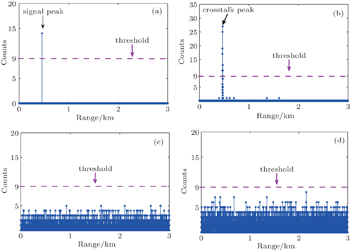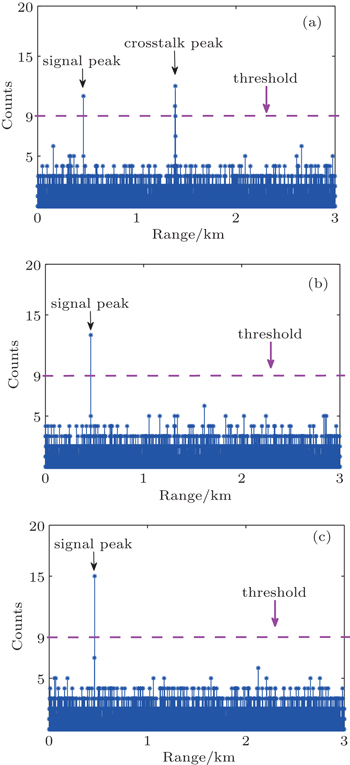† Corresponding author. E-mail:
‡ Corresponding author. E-mail:
Project supported by Tsinghua University Initiative Scientific Research Program, China (Grant No. 2014z21035).
A novel concept of collision avoidance single-photon light detection and ranging (LIDAR) for vehicles has been demonstrated, in which chaotic pulse position modulation is applied on the transmitted laser pulses for robust anti-crosstalk purposes. Besides, single-photon detectors (SPD) and time correlated single photon counting techniques are adapted, to sense the ultra-low power used for the consideration of compact structure and eye safety. Parameters including pulse rate, discrimination threshold, and number of accumulated pulses have been thoroughly analyzed based on the detection requirements, resulting in specified receiver operating characteristics curves. Both simulation and indoor experiments were performed to verify the excellent anti-crosstalk capability of the presented collision avoidance LIDAR despite ultra-low transmitting power.
With the increasing demands of the intelligent transportation system (ITS) and unmanned vehicles especially in dangerous or toxic environment, active collision avoidance has become a critical and urgent issue. Previous academic and commercial explorations on collision avoidance mainly focus on the solutions using microwave or ultrasonic sources,[1,2] compared to which the system based on light detection and ranging (LIDAR) has shown the advantage of higher spatial and temporal resolution, well suited to the modern transportation with increased complexity. Ai et al. reported a continuous-wave (CW) LIDAR operating at 635 nm with the power of several milliwatts, distance measurement ability of 200 m, and resolution of 3 m.[3] In 2011, an 808-nm coherent detection CW LIDAR with the transmitted laser power of 70 mW was proposed to obtain an enhanced resolution of 18 cm within the range of 130 m.[4] The required transmitted power as high as tens or even hundreds of milliwatts limits the miniaturization of the laser head and thus the LIDAR system. More importantly, laser source of this power level is usually operated at 532 nm, 808 nm, or 1064 nm, at which the damage threshold for human eyes is relatively low, leading to fairly high risk for eye safety in the public operational environment. To address the problem, our goal is to develop a compact eye-safe collision avoidance LIDAR with the maximum transmitting power of 100 μW at 1550 nm for a detection range of up to 500 m. The intensity of the returned signal, however, would be so weak that single-photon detection using time-correlated single photon counting (TCSPC) technology is required, which has been applied for general single-photon ranging and three-dimensional (3-D) imaging.[5–9] In 2007, MIT group reported a 3-D imaging single-photon LIDAR with the detection range of 150 m and the resolution of 3.65 m.[6] In 2009, a scanning time-of-flight imaging system capable of 325 m range detection and centimeter resolution was realized with an average output power of several microwatts.[9] TCSPC method has shown its excellent performance to distinguish the weak signal from a noisy background.
However, for collision avoidance scenarios, another issue, crosstalk, must be taken into consideration. As shown in Fig.
In this paper, an ultra-low power, anti-crosstalk collision avoidance LIDAR based on single-photon detection was presented. This approach not only enjoys the advantage of compact structure and eye safety, but also, by applying the CPPM pattern, successfully solves the crosstalk issue inherent in the context of vehicle collision avoidance. Parameters including pulse rate, discrimination threshold, and accumulation periods in TCSPC are optimized according to the detection requirements. In particular, an improved receiver operating characteristics (ROC) curve against the crosstalk is developed. Theoretical simulation and indoor experiments are then performed to validate the feasibility of the scheme and corresponding parameter settings. Both demonstrate that the proposed LIDAR design has excellent anti-crosstalk capability despite ultra-low laser power.
Figure
 | Fig. 2. Time sequences of transmitted pulses from vehicles A and B (solid line), returned pulses by vehicle B (dashed line), and crosstalk directly emitted from vehicle B (dotted line). |
As shown in Fig.

For the case of periodic transmitting pulses for both vehicles, we have




However, for the case of transmitting pulses with CPPM pattern, where {TA1, TA2, …, TAU} and {TB1, TB2, …, TBU} are respectively randomly distributed, Tct(n) is thus a random value instead of a fixed one for each storage period of TCSPC. Therefore, the crosstalk counts recorded in different periods would not add up but lead to a slight increase of the average background noise level. This is the reason why the CPPM pattern can resist the crosstalk.
A scheme of single-photon collision avoidance LIDAR with TCSPC method is demonstrated in Fig.
In our modeling, vehicles A and B are assumed to have the same transmitted laser average power of 100 μW, with the separation distance of 500 m. Table
| Table 1. Parameters of collision avoidance system. . |
The number of returned laser photons per pulse can be calculated using the LIDAR range equation. For a flat, diffusely reflecting, extended target (Lambertian target) whose area of surface is larger than the beam area, the returned signal photon per pulse Secho can be obtained[19–22] using the average power of transmitted laser beam PL, the target range L, the reflectance of the target surface ρ, and the receiver aperture area AR as

The number of crosstalk photons induced by the transmitter of vehicle B and received by vehicle A, as described in Fig.

The sunlight inside the receiver’s FOV is also collected, resulting in the background noise in the detector. The number of incident photons of the solar radiation during single period of TCSPC (10 μs in the modeling) is calculated as

With Φ = 0.3 W·m−2·nm−1 and Δλ = 0.5 nm, we obtain Nn = 90.02 photons/period. Since solar photon rate is assumed to be constant during each TCSPC period, there is an equal probability for the solar photons falling in each time bin, making the number of background noise in a single bin as n = NntresRr = 9 × 10−3, corresponding to a photon arrival rate of 9.0 MHz.
For single photon detectors, the detection probability p follows the Poisson statistics[23–27]


The SPD output can be described statistically as a Bernoulli process, since only one of the two outcomes (detected or not) can occur for each single TCSPC time bin. For a given threshold Th and an accumulation number of pulses U, the probability of detection Pdect_sig and the probability of false alarm in a single bin Pfa_single are given as

Based on the probability of false alarm in a single bin, the total probability of false alarm can be expressed as

To ensure the system stability, the total false alarm probability is required to be Pfa < 5% while the detection probability is required to be Pdect_sig > 95%, yielding the requirement on the probability of single bin false alarm as Pfa_single < 5.13 × 10−6. Besides, the photon level of background random noise can be calculated to be 4 × 106 s−1, i.e., the product of single bin false alarm probability of 0.004, as given in Eq. (
In order to extract the range information from the echo, the performance of p0 and p1s is firstly evaluated. A family of ROC curves[25] is computed to appropriately determine the number of pulses U required to build up the histogram as well as the detection threshold to identify the target, as shown in Fig.
 | Fig. 4. ROC curves that consider only the signal and background noise, drawn with the number of accumulated pulses U = 170, 180, 190, and 200. Here, Secho = 0.16, n = 0.009. |
For the above-mentioned ROC curves, merely the signal and the random noise are considered. With the crosstalk taken into account in the following, which would increase the noise level, a different selection of threshold and number of accumulation period is needed for signal identification.
The probability of false alarm in a single bin with crosstalk considered, p0_new, is adjusted as

 | Fig. 5. Improved ROC curves taking crosstalk into account, with the signal repetition rate of 100 kHz and the crosstalk repetition rate of (a) 100 kHz; (b) 2 MHz. |
The ROC curves considering the crosstalk in Fig.
Applying the optimized scheme of 200 pulse accumulations with the detection threshold of 9, simulations using Matlab were conducted with the results shown in Fig.
An initial conclusion can be made according to the theoretical simulation that the signal of CPPM pattern has outstanding anti-crosstalk capability, regardless of the crosstalk pattern and the crosstalk average repetition rate, which may need verification in the experiments stated in the following.
An indoor experiment was conducted to verify the anti-crosstalk capability of CPPM pattern, with the experimental setup shown in Fig.
A CW laser source was applied to introduce the background noises, the output of which was attenuated before being coupled into a 300-m-long fiber together with the attenuated output from laser A. Then, the output pulses from the fiber were combined with attenuated output from laser B, and then arrived at the detector. The fiber-coupled SPAD detector was operated at the bias voltage of 46 V, with the gate frequency of 100 MHz and the dark count measured as 100 s−1 that is negligible compared to the signal rate of 100 kHz, marking the detection events with successive high voltage levels with the pulse width of 5 ns. The photon level induced by the CW laser was set to be around 4 × 106 s−1, measured at the detector with laser A and B turned off, to realize the same level as that used in the modeling.
The experimental environment test results are described in Fig.
Figures
 | Fig. 9. The 100 kHz anti-crosstalk result for repetition rate signal with repetition rate crosstalk. |
Furthermore, experimental result with 100 kHz CPPM signal against 2 MHz periodic crosstalk is described in Fig.
In this paper, a novel concept of collision avoidance single-photon LIDAR for vehicles has been presented, in which the CPPM pattern was applied to the transmitting pulse train to solve the crosstalk problem for ITS system. To extract signal from strong background and crosstalk photon level, ROC curves taking into account the crosstalk issue were proposed to optimize the required number of accumulation pulses and the detection threshold, whose validity has been verified. Both theoretical simulations and indoor experiments were performed, which demonstrated that the proposed LIDAR concept using CPPM approach has excellent anti-crosstalk capability despite ultra-low laser power, and suggests that a vehicle equipped with single-photon CPPM collision avoidance LIDAR is immune to the crosstalk from other vehicles, regardless of transmitting pattern (periodic or CPPM) and crosstalk repetition rate. Free-space experiments of collision avoidance single-photon LIDAR using CPPM approach will be carried out in the near future.
| 1 | |
| 2 | |
| 3 | |
| 4 | |
| 5 | |
| 6 | |
| 7 | |
| 8 | |
| 9 | |
| 10 | |
| 11 | |
| 12 | |
| 13 | |
| 14 | |
| 15 | |
| 16 | |
| 17 | |
| 18 | |
| 19 | |
| 20 | |
| 21 | |
| 22 | |
| 23 | |
| 24 | |
| 25 | |
| 26 | |
| 27 |








